Maine forests are home to 50,000 species of wild animals and a large variety of tree species native to the region. The trees provide numerous environmental benefits, including purifying the air and helping with climate change by sequestering carbon dioxide from the atmosphere. Here we’ll discover 12 trees native to Maine.
Additionally, forests offer recreational areas for thousands of visitors each year who enjoy camping, fishing, hunting, and hiking within these lush woodlands. These forests provide a habitat for many animal species and act as renewable energy sources, with wood-burning electricity plants and hydroelectric dams that generate power.

The Pine Tree State
Maine was first named “The Pine Tree State” on February 1, 1895. This name was inspired by the white pine trees growing in abundance throughout Maine’s forests. The white pine tree is also a very important part of Maine’s history and culture, so much so that it was officially named the state tree in 1945. This nickname has been embraced by many Mainers over the years, with businesses and organizations using it proudly to represent their roots in this beautiful area.
So, why exactly did Maine get this title? Aside from its abundance of white pine trees, it could also have something to do with how important these majestic trees have become to the people who live here. They provide timber for building homes and furniture, shade during hot summer months, and are home to various local wildlife species. Whatever the reason for naming Maine “The Pine Tree State,” one thing is certain: It will continue to remain an integral part of life here for generations to come!
Why Plant Native Trees?
Native species are adapted to the climate and soil of their local environment, making them more likely to thrive. They also provide a greater variety of food sources for native wildlife and shelter in the form of nesting sites or windbreaks in rough weather.
Furthermore, planting native trees can help reduce runoff and flooding because their roots reach deeper than non-native trees. This quality helps them absorb more water from storms before it reaches our rivers and streams.
Planting native species is beneficial for wild animals and helps protect our ecosystems from harm caused by foreign plants, which may become invasive species.
Here are some of our favorite trees native to Maine!
1. Balsam Fir
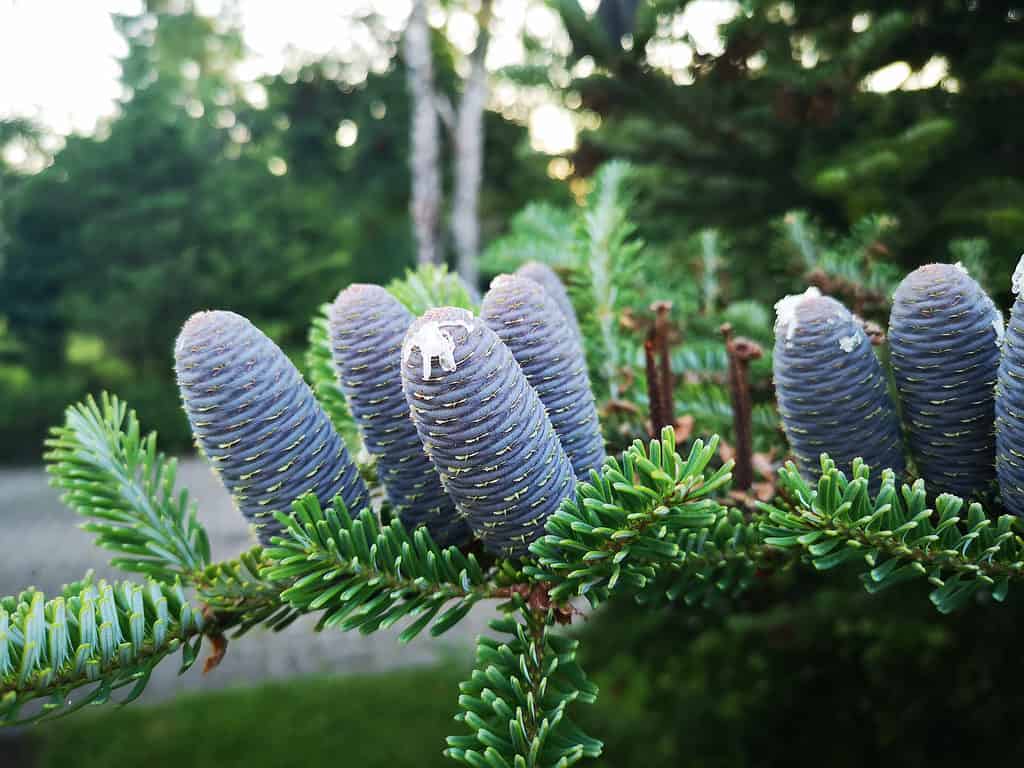
The balsam fir can serve as a food source.
©Kolde IT/Shutterstock.com
Balsam fir (Abies balsamea), also known as eastern balsam fir, is an evergreen tree native to Maine and other parts of North America. The bark of the balsam fir is dark gray with flat ridges, while its needles are short and soft. It has small cones that reach about 1 inch in length when ripe.
The balsam fir plays an important role in Maine’s wildlife ecosystem by providing habitat for fishers, snowshoe hares, ruffed grouse, black bears, and deer. Its dense foliage protects animals from the elements during cold winters.
In addition to offering shelter for wildlife, this tree also serves as a food source. Its leaves provide nutrition for browsing mammals like moose and white-tailed deer. At the same time, its buds offer sustenance to birds like chickadees and warblers. Additionally, its seeds are eaten by squirrels and chipmunks, which helps disperse them throughout the forest floor.
2. Eastern White Pine
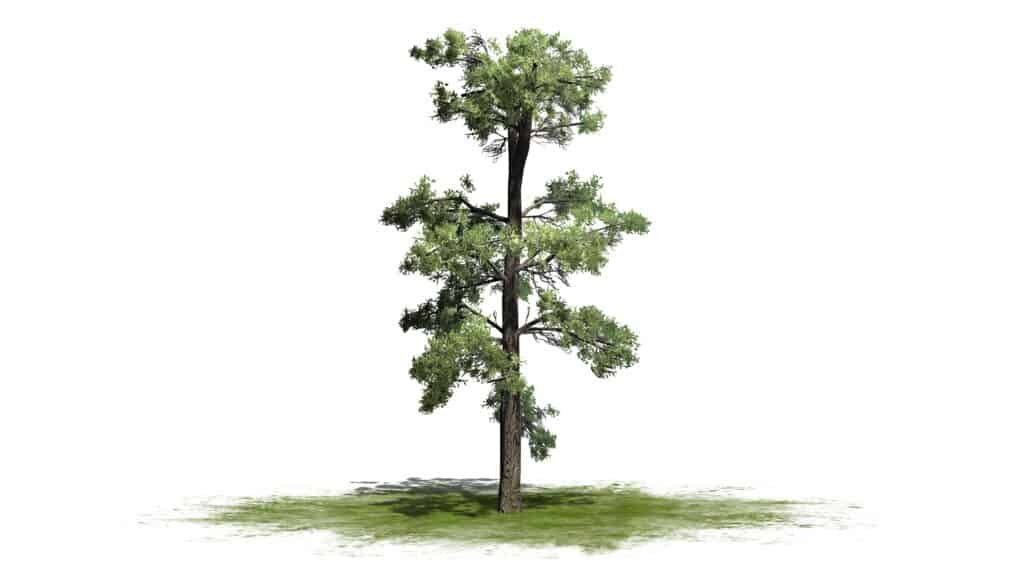
Eastern white pine is highly valued for its wood.
©Runa0410/Shutterstock.com
The eastern white pine (Pinus strobus) is a coniferous tree native to many parts of North America, including Maine. It can reach up to 80 feet tall, with a trunk diameter of up to three feet. The needles are long, soft, flexible, and bluish-green.
This tree is highly valued for its wood, which is light in weight yet strong and durable. Its branches form an umbrella shape that provides excellent cover from wind, rain, and snow and protection from predators for birds. The seeds and sap provide essential nutrition to wildlife in Maine. In addition, it provides another food source for animals in the area for insect species such as sawflies who feed on its foliage.
3. White Spruce
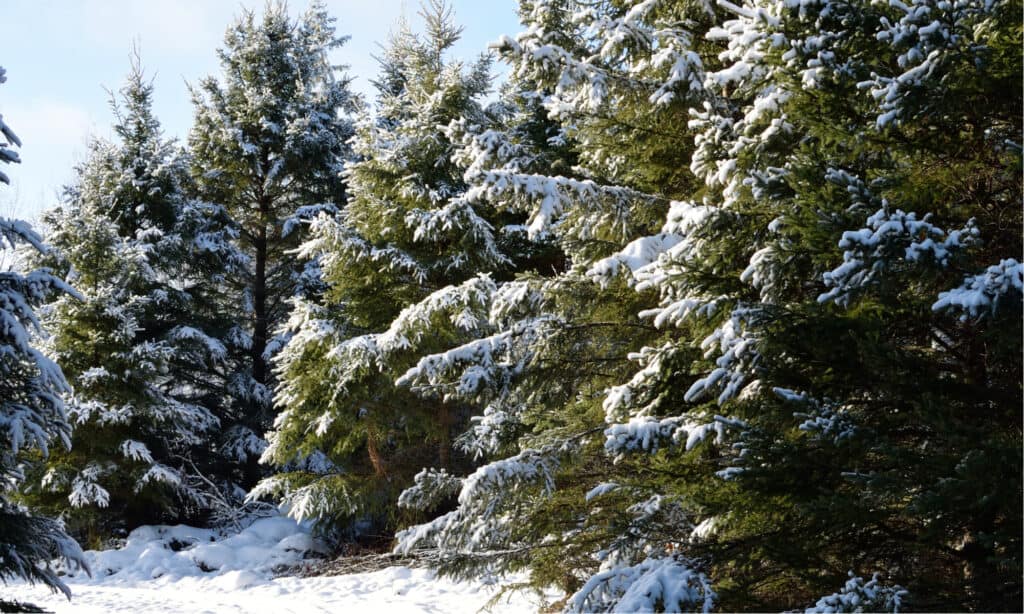
The dense foliage of white spruce provides shelter and nesting sites for birds.
©ClubhouseArts/Shutterstock.com
White spruce (Picea glauca) is an evergreen coniferous tree native to Maine and reaches up to 60 feet tall. It is an ideal choice for windbreaks, as it can provide strong protection from the harsh winter winds in the region.
Additionally, white spruce has many benefits for wildlife in Maine. Its dense foliage provides shelter and nesting sites for birds, while its seeds are popular food sources for small mammals such as squirrels and chipmunks. In addition, its needles produce acidic soil that supports certain types of ferns. These ferns are important habitats for invertebrates like insects or spiders.
4. Sugar Maple
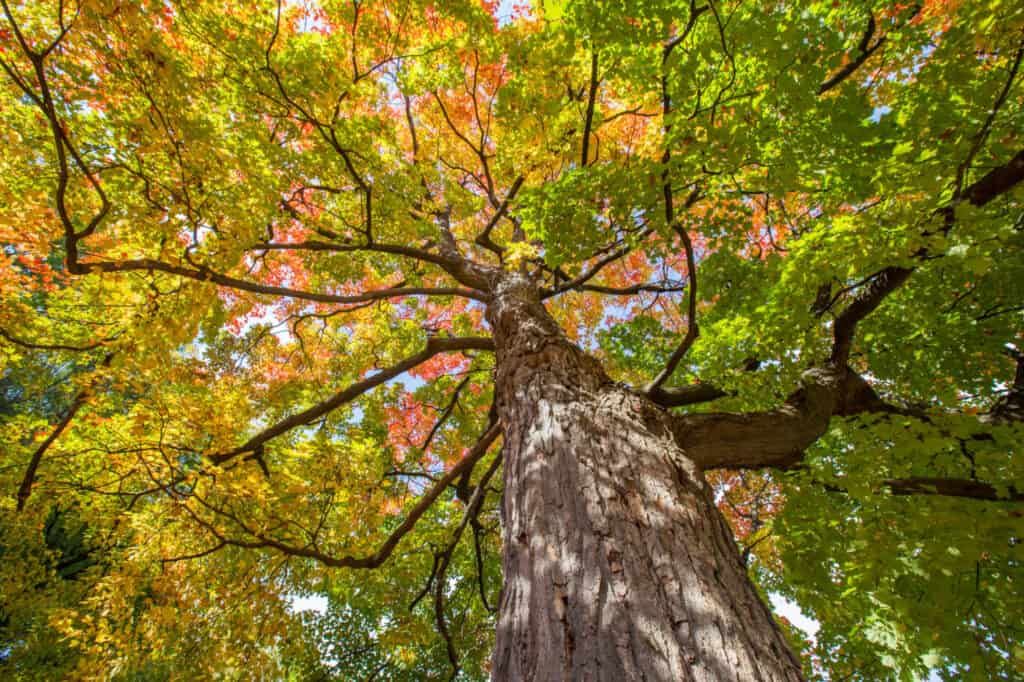
The sugar maple attracts insects which many animals eat.
©Mircea Costina/Shutterstock.com
The sugar maple (Acer saccharum) is an iconic tree native to Maine. It provides a variety of benefits to local wildlife. Its buds and seeds provide food for squirrels, birds, deer, chipmunks, bears, and moose. In addition, the sugar maple attracts insects which many animals also eat.
The dense canopy of this tree also provides cover for resting and nesting sites for wildlife, such as owls, rabbits, or hares. It can even be used as an escape route from predators. Furthermore, the sugar maple is a valuable nectar source for bees, which are crucial members of the ecosystem.
5. Yellow Birch

The yellow birch can grow up to 100 feet tall.
©iStock.com/Chantale Ouellet
Yellow birch (Betula alleghaniensis) is a native tree to Maine that grows up to 100 feet tall. It prefers cool, moist soil and can’t handle very hot summers. The bark of this tree is particularly striking with its yellowish-brown coloration, which contrasts nicely against the greens and blues of the surrounding landscape. Yellow birch may be one of the longest-lived trees in Maine. Some specimens are more than 200 years old!
Like many other trees, it provides essential benefits for wildlife found in Maine. It is a food source and habitat for birds, mammals, reptiles, and amphibians. Its wood has several uses, including furniture-making or fuel for fires due to its density.
6. Pagoda Dogwood

The pagoda dogwood is resistant to most diseases.
©iStock.com/seven75
Pagoda dogwood (Cornus alternifolia) is a deciduous tree native to Maine that can reach up to 25 feet tall. It blooms in early June with white flowers that are beneficial to wildlife and insects that use the nectar for sustenance. The foliage of this species is deep green, turning shades of yellow-orange or red during the fall.
Pagoda dogwood offers nesting sites for many birds due to its dense canopy structure. As a bonus, this tree requires very little maintenance once established and is resistant to most diseases common among trees.
7. Cockspur Thorn
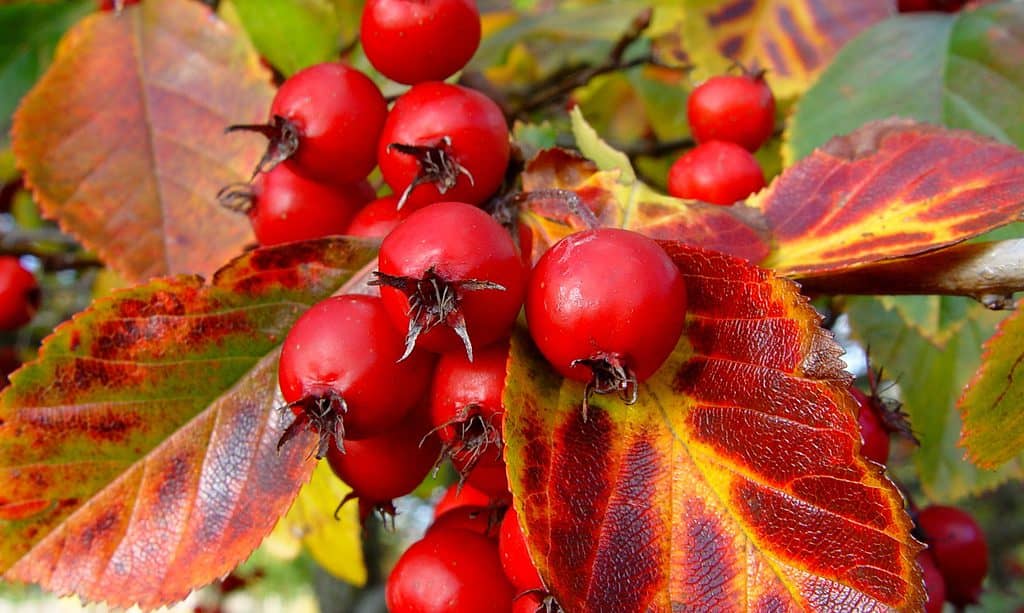
The dark red fruits produced by the cockspur thorn trees are beneficial to wildlife.
©iStock.com/gardendata
The cockspur thorn tree (Crataegus crus-galli) is a deciduous tree that can reach up to 30 feet in height. Its leaves are glossy green, with thorns about two inches long protruding from the branches.
The small dark red fruits produced by this species are attractive and beneficial to wildlife such as birds and small mammals. These trees prefer full sun and well-drained soils, and they thrive best in areas where summers are hot and humid. They make excellent ornamental trees for landscaping due to their beautiful foliage, fragrant flowers, and persistent fruit throughout the fall season.
8. Quaking Aspen
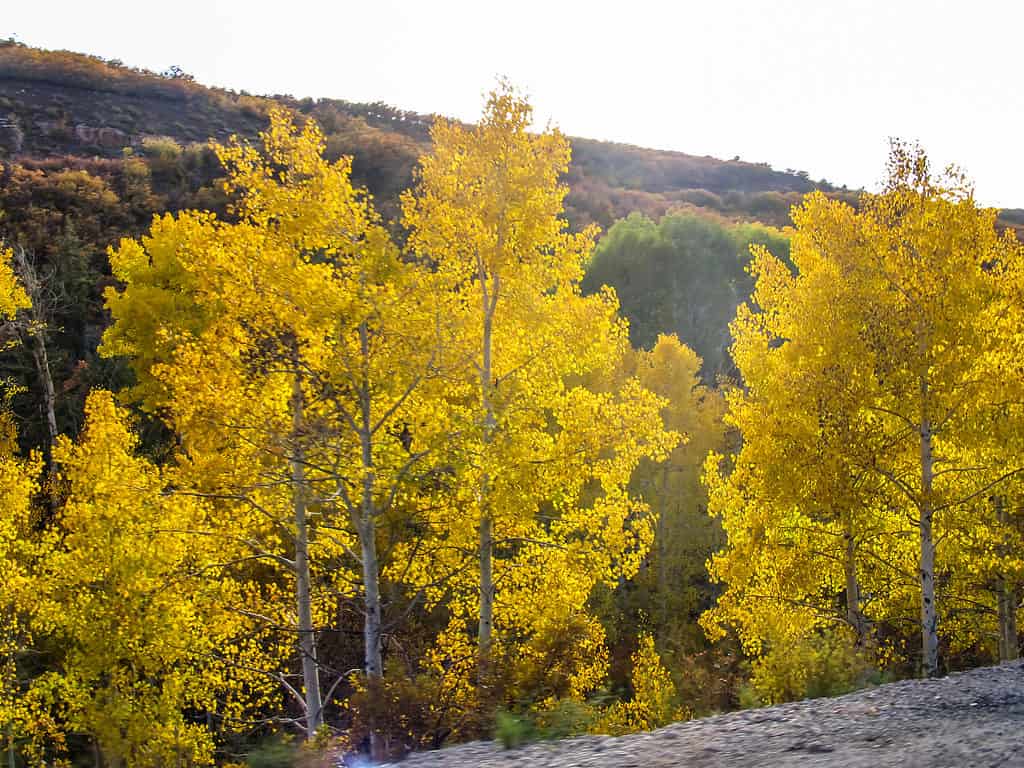
Quaking aspens provide an important food source for many animals.
©iStock.com/Marieke Peche
Quaking aspen (Populus tremuloides) is a fast-growing tree native to Maine that can reach up to 50 feet tall. It has beautiful yellow-gold fall foliage, making it an attractive addition to any landscape.
As well as being visually appealing, quaking aspens provide many benefits for wildlife in Maine. Small mammals such as squirrels and chipmunks feed on the buds of this tree, while birds like woodpeckers feast on its insects and larvae. Quaking aspens also provide shelter and nesting sites for both birds and small animals alike. During winter, deer browse the twigs when few other options are available.
9. Black Cherry

The black cheery grows in full sun and moist soil.
©iStock.com/TeleMakro Fotografie (Ina Hensel)
Black cherry (Prunus serotina) is a deciduous tree native to Maine. It grows in full sun and moist soil, typically reaching up to 60 feet tall. Its bark is an attractive black color with white flowers blooming in the springtime.
The berries of this tree are a crucial food source for many animals and birds throughout Maine. In particular, it nourishes songbirds like robins or waxwings and game birds such as grouse and turkey. Black cherry also attracts numerous other species of mammals, including squirrels, deer, bears, foxes, opossums, and raccoons, who feed on its fruits during late summer and early fall when preparing for a cold Maine winter.
10. Northern Red Oak
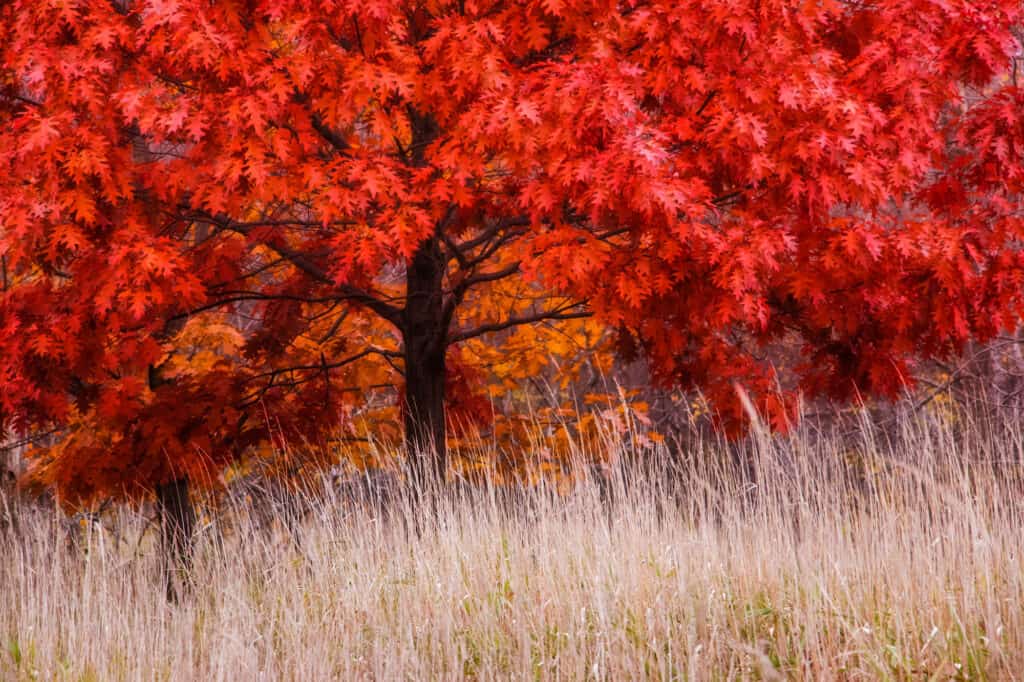
The northern red oak can grow up to 75 feet tall.
©iStock.com/Jean Landry
Northern red oak (Quercus rubra) is a deciduous tree native to Maine and grows in many areas throughout the state. It prefers full sun, though it can still do well in partially shaded areas and moderately moist soil. This majestic tree typically grows up to 75 feet tall with an impressive spread of around 50 feet wide.
The northern red oak gets established quickly after being planted and responds very well to transplantation efforts, making it perfect for those looking to populate their landscape with this iconic species. As fall approaches, the leaves turn a brilliant red color that stands out against other trees. Not only are these trees beautiful, but they also produce acorns which birds, deer, and squirrels love to eat!
11. American Beech
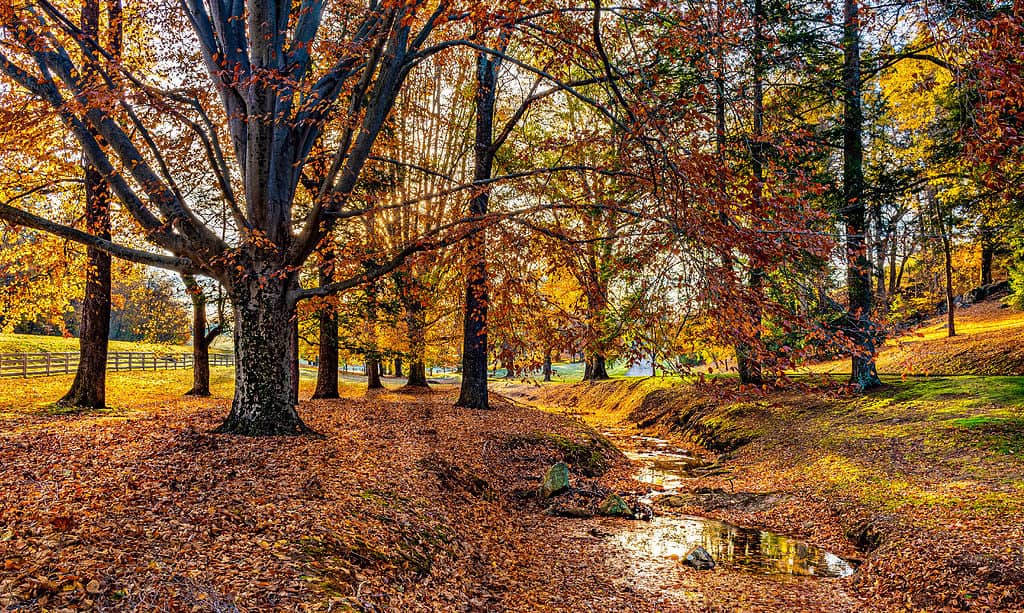
American beech offers refuge from predators for small mammals.
©Gerry Bishop/Shutterstock.com
The American beech (Fagus grandifolia) is a deciduous tree native to Maine. It grows 115 feet tall, has dark green leaves, and produces a nut-like fruit.
This hardwood tree provides food and shelter throughout all four seasons. In the springtime, its buds and flowers are eaten by various birds, such as chickadees, woodpeckers, nuthatches, and robins. During the summer months, these same birds rely on the beech trees’ nuts (beechnuts) as a source of fat-rich nutrition that helps them maintain their energy levels during the migration or when raising young chicks.
In the winter, deer like to feed on beechnuts when other food sources are scarce. The American beech also offers refuge from predators for small mammals like rabbits and squirrels who use cavities within the trunk as homes year-round. All told, this magnificent tree makes a valuable contribution to Maine’s diverse ecosystem!
12. Red Maple

Red maple trees turn beautiful colors in fall.
©iStock.com/JUN DONG
The red maple tree (Acer rubrum) is also known as the swamp maple. It grows 120 feet tall and is best known for its brilliant red fall color.
The red maple provides a variety of benefits to local wildlife. One of the main benefits is that it feeds white-tailed deer throughout the state. Several birds and mammals, including wild turkeys, wood ducks, grouse, and squirrels, consume its seeds (samaras). It is also the primary food for rosy maple moths when they are in the caterpillar stage.
Summary of 12 Incredible Trees Native to Maine
Here’s a recap of the dozen magnificent Maine native trees that we looked at.
| Number | Tree | Scientific Name | Size |
|---|---|---|---|
| 1 | Balsam Fir | Abies balsamea | Small cones reach about 1 inch in length when ripe |
| 2 | Eastern White Pine | Pinus strobus | Can grow up to 80 feet tall; trunk’s diameter grows up to 3 feet |
| 3 | White Spruce | Picea glauca | Grows up to 60 feet tall |
| 4 | Sugar Maple | Acer saccharum | Dense canopy provides cover for resting and nesting sites for wildlife |
| 5 | Yellow Birch | Betula alleghaniensis | Grows up to 100 feet tall |
| 6 | Pagoda Dogwood | Cornus alternifolia | Can be up to 25 feet tall |
| 7 | Cockspur Thorn | Crataegus crus-galli | Can be up to 30 feet tall |
| 8 | Quaking Aspen | Populus tremuloides | Can be up to 50 feet tall |
| 9 | Black Cherry | Prunus serotina | Typically reaches up to 60 feet tall |
| 10 | Northern Red Oak | Quercus rubra | Grows up to 75 feet tall with a spread of around 50 feet wide |
| 11 | American Beech | Fagus grandifolia | Grows 115 feet tall |
| 12 | Red Maple | Acer rubrum | Grows 120 feet tall |
The photo featured at the top of this post is © Ukrolenochka/Shutterstock.com
Sources
- Maine Foilage, Available here: https://www.maine.gov/dacf/mfs/projects/fall_foliage/kids/meforestfacts.html
- Department of Agriculture, Conservation and Forestry, Available here: https://www.maine.gov/dacf/php/pesticides/yardscaping/plants/n_trees.htm
- University of Maine, Available here: https://www.maine.gov/ifw/docs/Backyard_Components_UMExt_7137_BackyardHabitatComponents.pdf
- Maine Department of Inland Fisheries & Wildlife, Available here: https://www.maine.gov/ifw/fish-wildlife/wildlife/species-information/mammals/index.html#:~:text=Maine%20is%20well%20known%20for,also%20very%20popular%20with%20tourists.
Thank you for reading! Have some feedback for us? Contact the AZ Animals editorial team.






